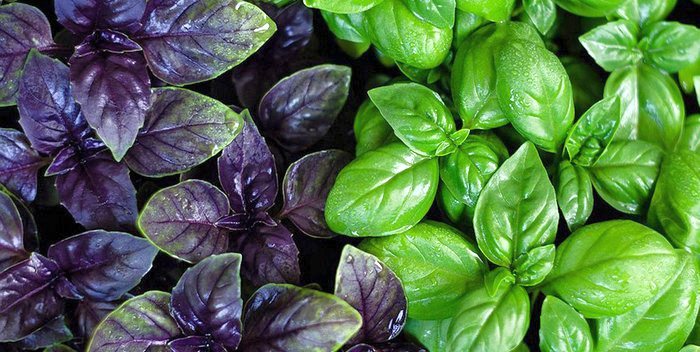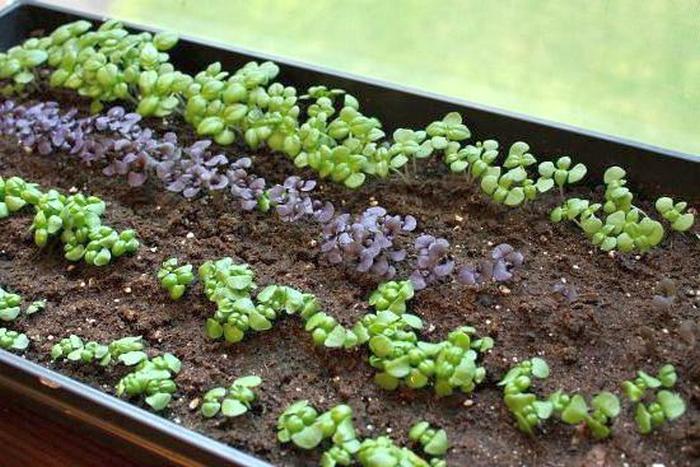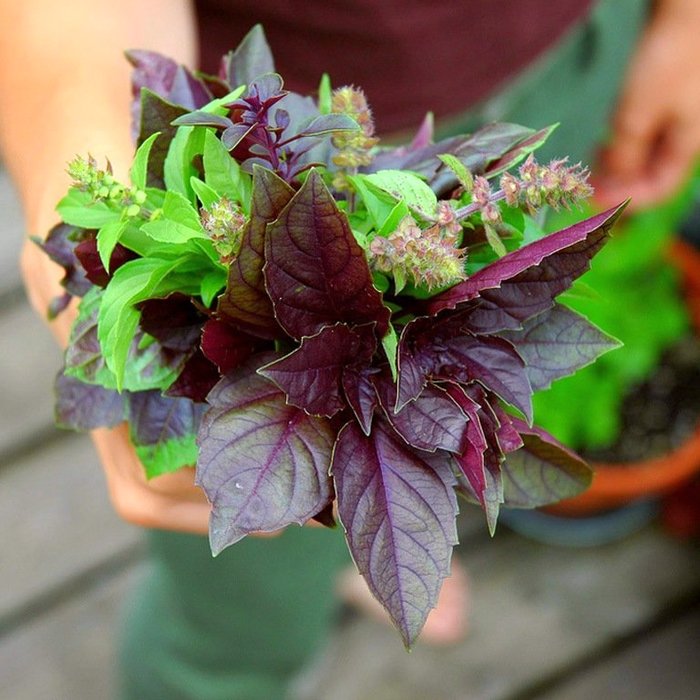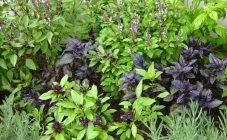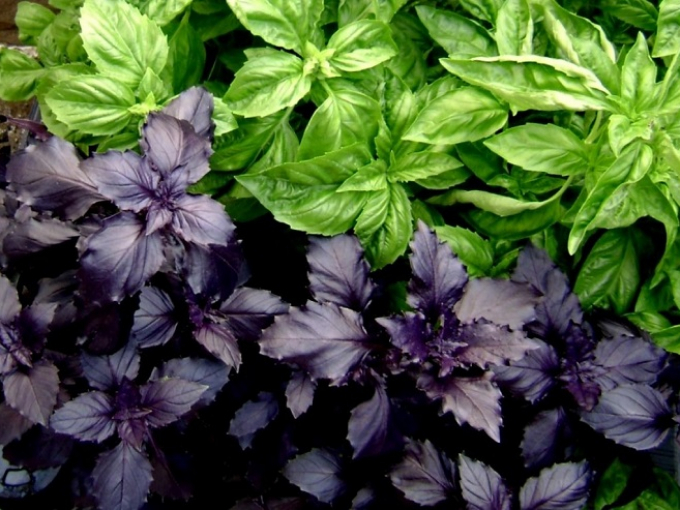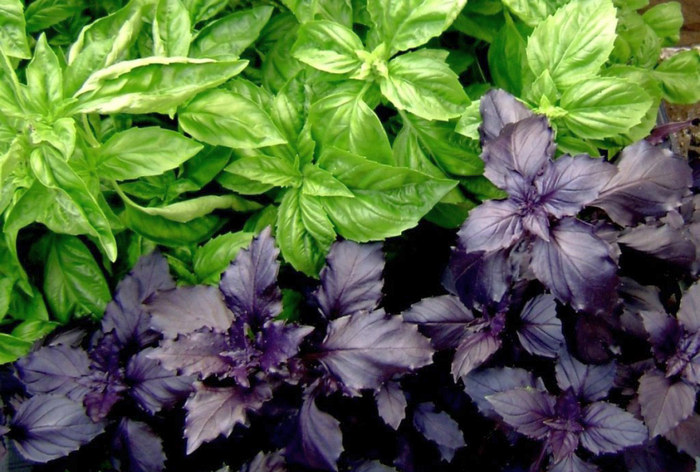Content:
Basil is associated primarily with classic Italian cuisine. Therefore, many people think that this fragrant herb originated in Italy. In fact, the birthplace of the basilica is Asia. This plant is very diverse in leaf color and aroma. In southern Europe, you can most often find green or light green basil. Despite its southern origin, basil can also be grown in our latitudes. Purple basil grows well in the middle lane, the Leningrad and Moscow regions, and even in the Urals and Siberia.
Agrotechnical requirements
Before you learn how to grow basil, you should carefully consider the basic requirements that this culture makes for planting conditions. The greatest yield can be obtained by planting basil in soft, fertile soil. Black earth or sandstone is best, but you can work with other types of soil as well. This will require improving their performance with nitrogen and potash fertilizers.
When the sprouts hatch from the soil, you need to provide generous watering with warm, settled water. For these purposes, you can select a separate container, for example, a barrel, and place it in the greenhouse. It is impossible to fill in the plants, since there is a high probability of the appearance of fungal diseases, but it is always necessary to monitor the constant moisture content of the soil. If there is a basil bay, then you need to loosen the soil so that air flows to the roots.
Sunlight is also important to this culture. It is best to place the beds in an open space or in the vicinity of young bushes and trees that give light shading. There is no need to plant basil next to dense plantings, it does not tolerate a strong shade and will definitely not grow well.
Reproduction of culture
2 methods are best for breeding:
- Basil seeds. This is the easiest way, which is guaranteed to give a positive result. Sowing of basil is carried out in mid-spring (1-2 ten days of April);
- Cutting is a method of propagation from ready-made material. You need to take several healthy twigs 7-10 cm long and place them in a container with clean water. To stimulate root formation, you can add Kornevin. After 14-20 days, the roots should appear, which means that the basil can be planted.
Sowing with seeds
Sowing times are slightly different, since you can plant basil seeds in open ground or in pots at home. The main condition is maintaining the temperature regime, seedlings appear at a temperature of + 23 ... + 25˚C. You need to sow seeds at home on April 10-15. Sowing in the garden depends on the weather conditions. In the southern regions, the optimal time for sowing in open ground is until May 10, in the middle lane - not earlier than mid-June.
Before sowing basil, you need to prepare the soil. It is best to make a mixture of peat, humus and universal soil or earth from a summer cottage. After that, you can spray the potassium-phosphorus composition diluted with water on the surface, according to the instructions on the package. Seeds need to be buried 1 cm. If sowing is done in open ground, then row spacing should be made about half a meter wide.When sowing in pots, the seeds are sown together with the subsequent picking of the basil in separate containers.
Sowing in pots
The pots are covered with foil or glass and left in a bright, warm place for 1-2 weeks until sprouts appear. From care during this period, it is necessary to ensure the moisture content of the soil, it should not dry out in any case. When 2 true leaves appear, the seedlings can be dived into separate containers. In this case, the planting depth does not change; there is no need to cover the sprout with earth. You can pinch the plant when 8 true leaves appear. This procedure provokes the appearance of side shoots. Hardening should be started 2 weeks before planting the basil outdoors. Containers with seedlings are taken outside every day, for a couple of hours.
Sowing in open ground
1 month before sowing, the bed is dug up and organic matter is introduced at the rate of 2 kg / m2. Compost or rotted manure is best. A couple of days before sowing, the bed is covered with a film or material to warm up the soil. Seeds are pickled with a 1% solution of potassium permanganate. On the day of sowing, the garden bed is watered with warm water. Seeds need to be spread out 1 piece every 20-25 cm. For reinsurance, you can make a denser sowing, and then thin out the seedlings. Seeds should be covered with a 1 cm layer of soil and covered with foil. After the sprouts appear, the film can be removed during the daytime, and at night it is worth continuing to cover it to protect it from temperature extremes.
Planting seedlings
Growing basil from seedlings is the most reliable way. Seedlings can be planted on the garden bed when the average daily air temperature is set at + 20˚C. Small fluctuations in temperature within ± 5 ˚C will not harm the plant.
It is best to decide on a landing site in the fall. This should be an area that is well lit most of the day, not blown by the wind. Flowers can be planted as a protective hedge. In the autumn, it is worth digging up the soil and assessing its quality. Clay soil should be diluted with sand and peat. To increase fertility, you can add a complex of organic and mineral fertilizers. Compost (2 kg / m2) and potassium-phosphorus fertilizers (according to the instructions) are well suited.
The undoubted plus of the basil is its unpretentiousness to its predecessors. This greatly expands the landing options. With the onset of spring, the selected bed must be loosened to a depth of 10-15 cm, cleaned of debris and weeds. Then, for 2-3 days, the bed must be covered with a film so that the earth warms up.
On the day of planting, grooves and holes need to be marked on the garden bed. When planting in rows, it is necessary to make the distance between the furrows 45-55 cm.If planting is carried out in the holes in a checkerboard pattern, then the distance between the holes should be about 30 cm.The depth of planting in both cases should not be more than 10 cm. The prepared seats should be watered and spray with a solution of mineral fertilizers. Seedlings are removed from the container along with an earthen lump, so as not to damage the root system, and placed in a planting hole. Sprinkle the seedling with earth not deeply, until the first bud.
Culture care
Although basil is of southern origin, cultivation is usually not a big problem. Planting and caring for basil outdoors is no different from other plants:
- Correct and timely watering - the key to good plant development. The soil should always be slightly damp. There is no specific watering frequency for basil. It is best to focus on the weather conditions. The basic rule is not to allow the soil to dry out. To provide air access to the roots, you can slightly loosen the soil before watering;
- Weed removal it is necessary, since it strongly draws nutrients from the soil, and also interferes with the development of the bush, filling the space in the garden;
- Fertilization need to be done 2-3 times per season. The first time - during planting, then 2 more dressings follow at intervals of 1 month. For the development of the deciduous part, you need to make nitrophoska at the rate of 1 tbsp. for 5-6 liters of warm, settled water. Finished fertilizer consumption - 3l / m2;
- Topping it is necessary for the bush to form a sufficient number of stems and grow well in width. At the level of 5-8 leaves, you need to pinch the shoot. In the case of planting basil seedlings, pinching can be done on the day of planting;
- Diseases... Most often, basil has a disease such as black leg - this is rotting of the plant stem. The cause of this disease is excessive watering. Preventive control measures are strict adherence to the water regime and its constant adjustment. In case of illness, it is necessary to stop watering, loosen the ground so that air begins to flow to the roots and stem. Treatment of the plant with Fundazol is acceptable. Although most often you have to remove the plant from the garden. When kept in a greenhouse, basil can be affected by gray rot fungus and fusarium. The reason for this is hot, humid air. As a preventive measure, a thin layer of ash is sprinkled on the soil once a week. Spraying the plants with an infusion of onion peel with water in a ratio of 1: 4 helps to get rid of the fungus. Of the insects, basil is most often damaged by aphids. It is not worth treating the bushes with chemicals, since they cannot be eaten. Spraying with soapy water or infusion of aromatic herbs (garlic, wormwood and others) saves the plant from parasites.
How to harvest
Basil is consumed fresh by adding the leaves to a salad, or as a dry seasoning used in meat and vegetable dishes. Basil is not suitable for freezing, as it loses its taste and nutrients.
Harvesting involves cutting the leaves. The term for this procedure is the end of July-mid-September. If peduncles are removed simultaneously with the cutting of the deciduous part, then the volume of the green mass of the plant will increase, and, accordingly, the yield will increase.
Seed collection is done towards the end of September. Previously, it makes no sense to do this, since they are not yet ripe, which means they are not suitable for planting next year.
Basil is dried in small bunches in a dark room with good ventilation. You can dry the leaves separately. To do this, they are laid out on the surface in one layer, it is desirable that they do not touch each other. The finished seasoning is packed in paper bags or glass jars.
It is better to choose a planting method in advance, since basil can only be grown in warm conditions. If the summer in the region allows you to withstand temperatures above + 20˚C, then you can safely plant the plant in the country in the open ground. In the absence of the necessary conditions, it is recommended to grow this herb on a windowsill or in a greenhouse / greenhouse.
